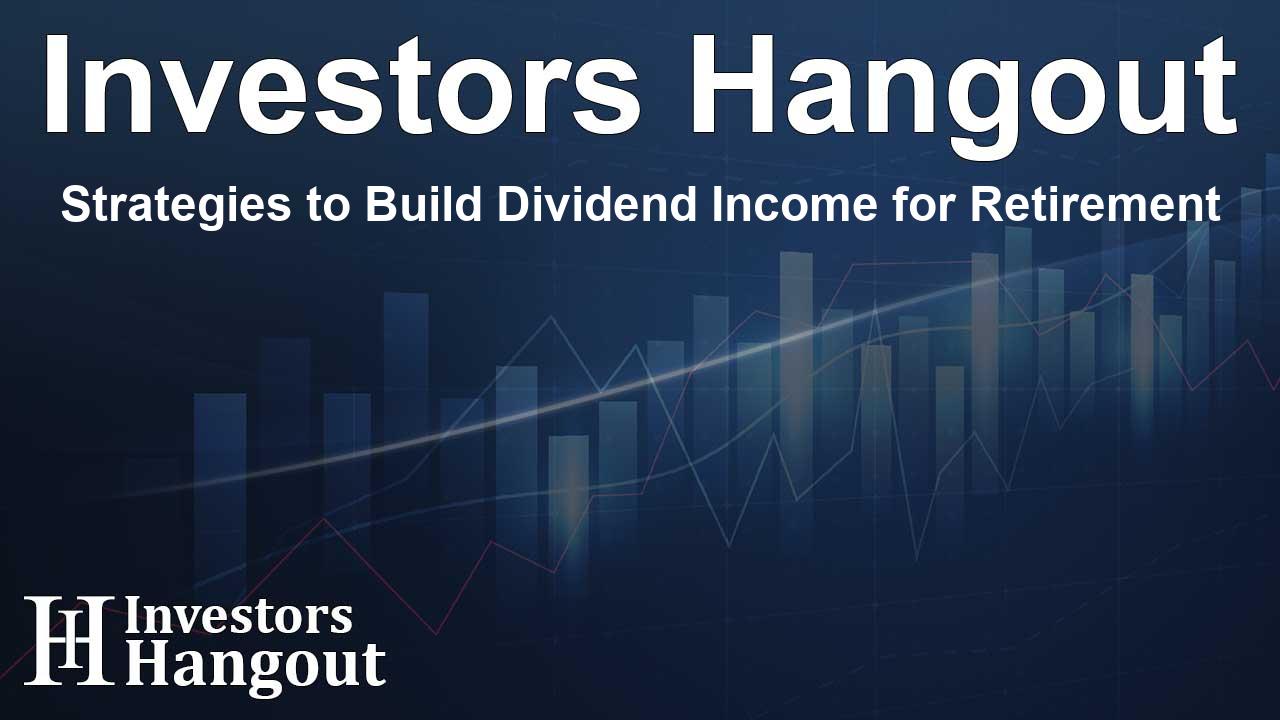Strategies to Build Dividend Income for Retirement

Building a Sustainable Dividend Income Strategy
Planning for retirement can feel overwhelming, especially when it comes to ensuring you have enough savings. Imagine being able to generate an additional $50,000 each year during retirement—this could greatly ease your financial concerns. While this goal may seem unattainable without a large initial investment, it is achievable with time and careful planning.
If you have about 30 years before you retire, let’s look at how making consistent monthly investments can lead to a strong retirement fund, particularly when you choose the right investment vehicles.
Initial Growth Strategy: Building Your Portfolio
To start earning reliable dividends, it's crucial to create a substantial investment portfolio. Generally, to generate $50,000 in dividends, you would need a portfolio valued at around $1 million, which reflects a yield of about 5%. For a more cautious approach, consider targeting a portfolio worth approximately $1.3 million, which could yield around 3.8%. This conservative strategy helps to minimize risks associated with higher yields.
Shifting from growth investments to dividend-focused assets through Exchange-Traded Funds (ETFs) can be a wise and effective move. By initially investing in growth-oriented assets, you can take advantage of the long-term potential of high-quality growth stocks, even if you experience market fluctuations in the early years.
ETFs are particularly advantageous as they allow you to invest in a wide range of stocks, thereby lowering your overall risk. This diversification can yield solid long-term returns without the volatility often seen with individual stocks. For example, popular ETFs like Invesco QQQ Trust (NASDAQ: QQQ) offer exposure to a selection of top-performing non-financial companies, while the Technology Select Sector SPDR Fund (NYSEMKT: XLK) focuses specifically on the tech industry. Both can serve as strong investment options.
The Power of Long-term Growth Returns
Investing in funds like the Technology Select Fund, which has delivered total returns exceeding 520% over the last decade, illustrates the potential for significant wealth accumulation. In comparison, the Invesco QQQ Trust has achieved an impressive 415% return during the same period. While predicting future market trends can be challenging, maintaining a balanced portfolio with both funds may be a prudent strategy for long-term growth.
Fortunately, a compound annual growth rate (CAGR) of 17.8% with the Invesco Trust suggests strong returns, while the Technology Select Fund averages over 20%. These returns can help accelerate your portfolio's growth, making it easier to reach your dividend income goals.
Realistic Growth Projections for Your Investments
While it's important to have positive expectations regarding annual returns, aiming for a 17% growth rate every year for 30 years may be overly optimistic. Depending on market conditions, a more realistic growth rate would be between 10% and 15%. To reach $1.3 million with a monthly investment of $300, you should anticipate an average return of around 13% throughout your investing years. However, increasing your monthly investment will certainly help you achieve this goal more quickly.
Once you have built a portfolio of $1.3 million, you can make significant investments in various dividend-focused funds, such as the SPDR Portfolio S&P 500 High Dividend ETF, which currently offers a yield of 4.3%. This could potentially generate around $56,000 annually in dividends. By maintaining a healthy balance in your portfolio, you will have many more options for future investments.
ETFs: The Best Investment for Growth
Initially, investing in individual high-tech stocks may seem attractive. However, opting for strong ETFs like Invesco or the Technology Select Sector ETF not only simplifies your investment process but also significantly lowers your risk. By choosing this path, generating sustainable and substantial dividend income becomes more manageable as you approach retirement, providing you with a solid balance to secure your financial future.
Should You Invest in Invesco QQQ Trust Today?
Before diving into investments with Invesco QQQ Trust, it's wise to conduct thorough research. A wealth of information is available to help you build a strong investment strategy. Be sure to continuously evaluate the market landscape and stay informed about emerging opportunities that can provide extraordinary dividends while minimizing risks.
Frequently Asked Questions
1. What are the benefits of investing in ETFs for retirement?
ETFs provide diversification, which helps reduce risk while offering potential growth through investments in multiple stocks within a single fund.
2. How much do I need to invest monthly to reach $1.3 million?
To achieve a goal of $1.3 million over 30 years, a monthly investment of $300, assuming an average annual return of around 13%, would be necessary.
3. What is a reasonable yield to expect from a retirement portfolio?
A conservative yield of approximately 3.8% is reasonable and could potentially generate $50,000 annually from a $1.3 million investment.
4. Can market fluctuations impact my investment strategy?
Yes, market fluctuations can influence returns, but a long-term investment strategy focused on growth stocks generally helps mitigate these risks.
5. Why is focusing on growth investments essential for retirement planning?
Growth investments are vital as they help build the initial capital needed to generate dividend income, leading to a more secure financial future.
About The Author
Contact Owen Jenkins privately here. Or send an email with ATTN: Owen Jenkins as the subject to contact@investorshangout.com.
About Investors Hangout
Investors Hangout is a leading online stock forum for financial discussion and learning, offering a wide range of free tools and resources. It draws in traders of all levels, who exchange market knowledge, investigate trading tactics, and keep an eye on industry developments in real time. Featuring financial articles, stock message boards, quotes, charts, company profiles, and live news updates. Through cooperative learning and a wealth of informational resources, it helps users from novices creating their first portfolios to experts honing their techniques. Join Investors Hangout today: https://investorshangout.com/
The content of this article is based on factual, publicly available information and does not represent legal, financial, or investment advice. Investors Hangout does not offer financial advice, and the author is not a licensed financial advisor. Consult a qualified advisor before making any financial or investment decisions based on this article. This article should not be considered advice to purchase, sell, or hold any securities or other investments. If any of the material provided here is inaccurate, please contact us for corrections.
